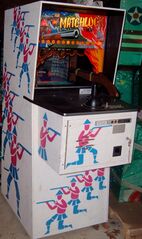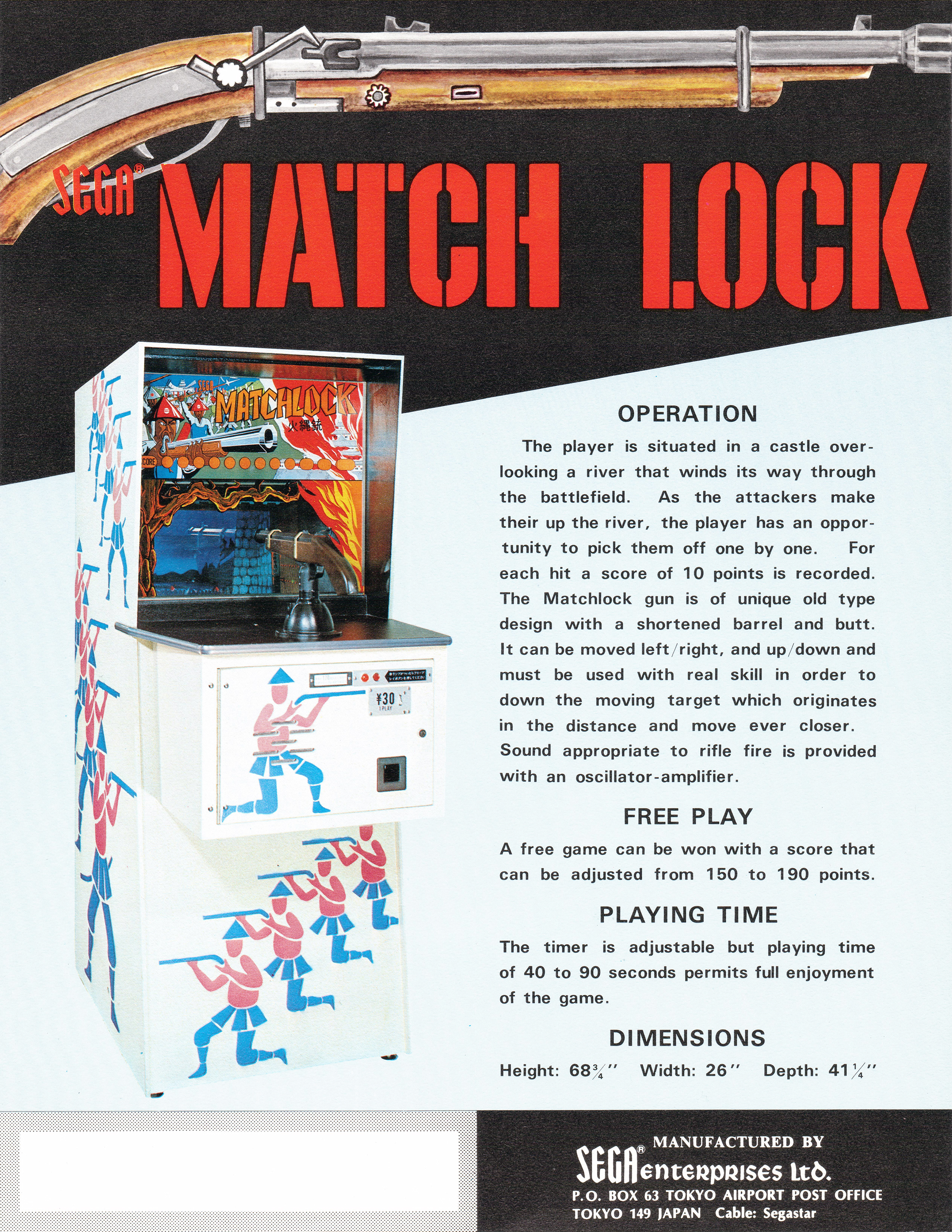Difference between revisions of "Matchlock"
From Sega Retro
m |
m (Without wanting to blame anyone... I'm going to remove this part ... when this page was created this is what was put on it and the source was this website : https://www.pinrepair.com/arcade/matchlo.htm (that was the guy's perception)... we're not that stupid... there's nothing politically incorrect or racist in this game... it just simulates a battle from the days of feudal Japan... credits to our friend CartridgeCulture who has a good writing style...) |
||
| Line 8: | Line 8: | ||
| releases={{releasesArcade | | releases={{releasesArcade | ||
| em_date_jp=1972{{ref|https://web.archive.org/web/20230819003054/http://thetastates.com/eremeka/1970s.html}} | | em_date_jp=1972{{ref|https://web.archive.org/web/20230819003054/http://thetastates.com/eremeka/1970s.html}} | ||
| − | | em_rrp_jp= | + | | em_rrp_jp=340,000{{fileref|SEGA Price List 1972-09-01 JP.pdf|page=6}}{{fileref|SEGA Price List 1973-01-01 JP.pdf|page=9}}{{fileref|1977SegaPriceList JP.pdf|page=6}} |
| em_date_us=1972{{ref|https://web.archive.org/web/20230819003054/http://thetastates.com/eremeka/1970s.html}} | | em_date_us=1972{{ref|https://web.archive.org/web/20230819003054/http://thetastates.com/eremeka/1970s.html}} | ||
}} | }} | ||
| Line 19: | Line 19: | ||
==Gameplay== | ==Gameplay== | ||
| − | On a [[wikipedia:History of Japan#Feudal Japan|feudal Japanese]] battlefield, players are tasked with shooting oncoming hordes of ''[[wikipedia:Ashigaru|ashigaru]]'' (足軽) foot soldiers with a swivel-mounted replica of a ''[[wikipedia:Tanegashima (gun)|tanegashima]]'' (種子島) matchlock rifle (the weapon is more commonly known as a ''hinawajū'' (火縄銃), the kanji for which appears on the cabinet itself.{{fileref|Matchlock machine2.jpg}}) Enemies approach the player's [[wikipedia:Japanese castle|Japanese castle]] (城) in diagonal rows, and upon being shot, dramatically emit a digitized scream | + | On a [[wikipedia:History of Japan#Feudal Japan|feudal Japanese]] battlefield, players are tasked with shooting oncoming hordes of ''[[wikipedia:Ashigaru|ashigaru]]'' (足軽) foot soldiers with a swivel-mounted replica of a ''[[wikipedia:Tanegashima (gun)|tanegashima]]'' (種子島) matchlock rifle (the weapon is more commonly known as a ''hinawajū'' (火縄銃), the kanji for which appears on the cabinet itself.{{fileref|Matchlock machine2.jpg}}) Enemies approach the player's [[wikipedia:Japanese castle|Japanese castle]] (城) in diagonal rows, and upon being shot, dramatically emit a digitized scream. |
The replica matchlock rifle is notable for using built-in recoil to simulate firing an actual weapon. | The replica matchlock rifle is notable for using built-in recoil to simulate firing an actual weapon. | ||
Latest revision as of 09:09, 17 June 2024

| |||||||||||||
| Matchlock | |||||||||||||
|---|---|---|---|---|---|---|---|---|---|---|---|---|---|
| System(s): Electro-mechanical arcade | |||||||||||||
| Publisher: Sega | |||||||||||||
| Developer: Sega | |||||||||||||
| Number of players: 1 | |||||||||||||
|
This short article is in need of work. You can help Sega Retro by adding to it.
Matchlock is an electro-mechanical arcade shooting gallery game developed and manufactured by Sega. Released exclusively in the United States in 1972, it is notable for its early use of solid-state digitized sound samples.
Contents
Specifications
Dimensions
Gameplay
On a feudal Japanese battlefield, players are tasked with shooting oncoming hordes of ashigaru (足軽) foot soldiers with a swivel-mounted replica of a tanegashima (種子島) matchlock rifle (the weapon is more commonly known as a hinawajū (火縄銃), the kanji for which appears on the cabinet itself.[5]) Enemies approach the player's Japanese castle (城) in diagonal rows, and upon being shot, dramatically emit a digitized scream.
The replica matchlock rifle is notable for using built-in recoil to simulate firing an actual weapon.
Scoring
Each successful hit is worth 10 points, and a free game is awarded between 140 and 190 points.




